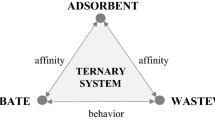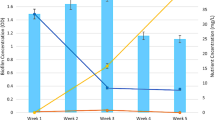Abstract
In this study, we investigated the structural characteristic and biochemical properties of waste-activated sludge after thermochemical pretreatment. The results show that with the increase dosage of hydrochloric acid or sodium hydroxide, the concentration of suspended solid (SS) and volatile suspended solids (VSS) declined, especially at pH 12 + H (“H” means heating). At the same time, soluble chemical oxygen demand (SCOD) all increased as well, especially at pH 12, the greatest lysis effect appeared. Protein and polysaccharide presented a similar law with SCOD. Furthermore, the specific surface area (SSA), two-dimensional fractal dimension (D 2), and three-dimensional fractal dimension (D 3) all increased to a certain degree with acid/alkali pretreatment whether or not heating. Otherwise, the median particle size (d 0.5) and zeta potential decreased leading to more compact and stable floc structure and reduction effect compared with the original sludge. In Pearson correlation analysis, SSA and SS, SSA and VSS, zeta potential and SCOD, and zeta potential and protein have significant negative correlations; D 3 and SSA have a significant correlation with SS, VSS, SCOD, and protein. Consequently, measuring the structural parameters D 3 and SSA online can reflect the effects of sludge lysis indirectly, which will be helpful to guide the practical application.








Similar content being viewed by others
References
APHA. (1995). Standard methods for the examination of water and wastewater. Washington, DC: American Public Health Association.
Bougrier, C., Delgene’s, J. P., & Carre’re, H. (2008). Effects of thermal treatments on five different WAS samples solubilisation, physical properties and anaerobic digestion. Chemical Engineer, 139(2), 236–244.
Britt-Marie, W., Bo, J., & Paul, L. (2003). Impacts of structural characteristics on activated sludge floc stability. Water Research, 37, 3632–3645.
Braguglia, C. M., Gianico, A., & Mininni, G. (2012). Comparison between ozone and ultrasound disintegration on sludge anaerobic digestion. J. Environ.Manage., 95, 139–143.
Do, K.-U., Banu, J. R., & Chung, I.-J. (2009). Effect of thermochemical sludge pretreatment on sludge reduction and on performances of anoxic-aerobic membrane bioreactor treating low strength domestic wastewater. Journal of Chemical Technology& Biotechnology., 84(9), 1350–1355.
Dubois, M., Gilles, K. A., Hamilton, J. K., Rebers, P., & Smith, F. (1956). Colorimetric method for determination of sugars and related substances. Anal.Chem., 28, 350–356.
Du, L. X. (1992). Industrial microbiology experimental technique (pp. 32–42). China: Tianjin Science and Technology Press.
Eastman, J. A., & Ferguson, J. F. (1981). Solubilization of participate organic carbon during the acid phase of anaerobic digestion. Water Pollution Control Federation., 53(3), 352–366.
FrØlund, B., Keiding, K., & Nielsen, P. (1995). Enzymatic activity in the activated sludge flocs matrix. Applied Microbiology and Biotechnology, 43(4), 755–761.
Gao, J.F., Su, K., Zhang, Q., Chen, R.N., Wang, J.H.,Peng, Y.Z. (2010). Fractal characteristics of mature aerobic granular sludge cultivated by different carbon sources. Environmental Science, 31, 1871−1876.
Guan, J., Waite, T.D., Amal, R. (1998). Rapid structure characterization of bacterial aggregates. Environmental Science & Technology, 32, 3735−3742.
Guo, W. Q., Ding, J., Cao, G. L., Ren, N. Q., & Cui, F. Y. (2011). Treatability study of using low frequency ultrasonic pretreatment to augment continuous biohydrogen production. Hydrogen Energy., 36, 14180–14185.
Kampasa, P., Parsonsa, S. A., Pearceb, P., Ledouxb, S., Valec, P., Churchleyc, J., & Cartmella, E. (2007). Mechanical sludge disintegration for the production of carbon source for biological nutrient removal. Water Research, 41, 1734–1742.
Liao, B. Q. (2000). Physicochemical studies of microbial flocs (pp. 103–104). Canada: University of Toronto.
Lowry, O. H., Rosebrough, N. J., Farr, A. L., & Randall, R. J. (1951). Protein measurement with the Folin phenol reagent. Journal of Biological Chemistry., 193, 265–275.
Mandelbrot, B. B., & Wheeler, J. A. (1982). The fractal geometry of nature (pp. 1–60). New York: W. H. Freeman & Company.
Neyens, E., Baeyens, J., Weemaes, M., 2003. Hot acid hydrolysis as a potential treatment of thickened sewage sludge. Journal of Hazardous Materials. 275–293.
Nguyen, M. T., Mohd, Y. N. H., Miyazaki, T., & Maeda, T. (2014). Enhancement of sludge reduction and methane production by removing extracellular polymeric substances from waste activated sludge. Chemosphere, 117, 552–558.
Sheng, Y.X., Cao, H.B., Li Y.P., Zhang, Y., 2008. Effect of pretreatment methods on breaking up bacteria and solubilization of organic substances in waste activated sludge. Journal of Chemical Industry and Engineering, China. 1496–1501.
Spicer, P. T., Pratsinis, S. E., Raper, J., Amal, R., Bushell, G., & Meesters, G. (1998). Effect of shear schedule on particle size, density, and structure during flocculation in stirred tanks. Powder Technology, 97, 26–34.
Takashima, M., & Tanaka, Y. (2010). Application of acidic thermal treatment for one and two-stage anaerobic digestion of sewage sludge. Wat Sci Technol., 11, 2647–2654.
Wang, Z. J., & Wang, W. (2005). Thermal hydrolysis test of surplus sludge. China Environmental Science., 25, 56–60.
Wang, X. X., Lv, S. G., Qiu, Z. F., & Ying, W. C. (2010). Comparison of waste activated sludge solubilization treated by sonication, thermal treatment and acid-alkali adjustment. Environmental Pollution and Control, China., 32, 56–61.
Wilson, C. A., & Novak, J. T. (2009). Hydrolysis of macromolecular components of primary and secondary wastewater sludge by thermal hydrolytic pretreatment. Water Research, 43, 4489–4498.
Xiao, B. Y., & Liu, J. X. (2006). Study on treatment of excess sludge under alkaline condition. Environmental Science., 27, 319–323.
Xiao, B. Y., & Liu, J. X. (2008). Impacts of different pretreatments on characteristics of excess sludge. Environmental Science., 29, 327–331.
Xie, M., Huang, C., Liu, X. B., Li, M. Y., & Ou, S. H. (2014). Effect of acid/alkali lysis on the characteristics and reduction efficacy of sludge in continuous running systems. Industrial Water Treatment., 34, 25–28.
Yu, G.H., He, P.J., Shao, L.M., He, P.P. (2008). Toward understanding the mechanism of improving the production of volatile fatty acids from activated sludge at pH 10.0. Water Research, 42, 4637−4644.
Yu, Q., Lei, H. Y., Yu, G. W., Feng, X., Li, Z. X., & Wu, Z. C. (2009). Influence of microwave irradiation on sludge dewaterability. Chem.Eng., 155, 88–93.
Zhang, J., Zhang, J., Tian, Y., Li, N., Kong, L. C., Sun, L., Yu, M., & Zuo, W. (2016). Changes of physicochemical properties of sewage sludge during ozonation treatment: correlation to sludge dewaterability. Chemical Engineer, 301, 238–248.
Zhou, D. Q. (1993). HEP, Higher Education Press, Beijing, pp. 204–220.
Zhu, Z., Li, T., Wang, D. S., & Yao, C. H. (2008). Effect of pH on surface properties and physical structure of activated sludge flocs. Environmental Engineering, China., 12, 1599–1604.
Zhou, Z., Q, W. M., Xing, C., Shen, X. L., Hu, D. L., & Wang, L. C. (2014b). A micro-aerobic hydrolysis process for sludge in situ reduction: performance and microbial community structure. Bioresource Technology, 173, 452–456.
Acknowledgements
This work was funded by the National Natural Science Foundation of China (Grant No. 51108043), Key Project of Hunan Province Department of Education (Grant No. 15A002). We also thank for the support from Prof. Junxin Liu and Benyi Xiao from Research Center for Eco-Environmental Science, Chinese Academy of Sciences, Beijing.
Author information
Authors and Affiliations
Corresponding author
Rights and permissions
About this article
Cite this article
Xie, M., Wang, C., Liu, X. et al. Characteristics of Biochemical and Fractal Structure of Activated Sludge with Thermochemical Lysis. Water Air Soil Pollut 228, 187 (2017). https://doi.org/10.1007/s11270-017-3351-3
Received:
Accepted:
Published:
DOI: https://doi.org/10.1007/s11270-017-3351-3




